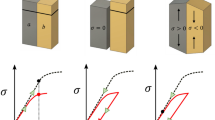Abstract
This paper presents the methodology employed in the determination of the stress tensor for thin crystalline films using x-ray rocking curves. Use of the same equipment for the determination of the average stress in poly- or non-crystalline thin films attached to a crystalline substrate is also discussed. In this case the lattice curvature of the substrate is determined by measurement of the shift In the Bragg peak with lateral position in the substrate.
Strains in single crystal layers may be measured using Bragg diffraction from the layers and from the substrate or a reference crystal, with the highest strain sensitivity of any known technique. The difference in Bragg angles for a strained and an unstrained crystal is related to the change in d spacing of the Bragg planes, and the elastic strain is related to’this angular difference. The separation of two peaks on an x-ray rocking curve is generally not equal to the difference in Bragg angles of two diffracting crystals, so diffractometer measurements must be carefully Interpreted in order to obtain x-ray strains in crystalline films (x-ray strains are strains relative to the reference crystal). The unstrained d spacings of the film and the d spacings of the reference crystal must be known to obtain the elastic strains in the film, from which the stress tensor is determined.
Similar content being viewed by others
References
V. Bonse and I. Hartmann, Z. Kristallogr. 156, 256 (1981).
J. W. M. DuMond, Phys. Rev. 52, 812 (1973).
V. S. Speriosu, J. Appl. Phys. 52, 6094 (1981).
W. H. Zachariasen. Theory of X-ray Diffraction in Crystals, (Wiley, New York, 1945).
VS. Speriosu and T. Vreeland, Jr., J. Appl. Phys. 56, 1591 (1984)
Thad Vreeland, Jr., J. Mater. Res. 1, 712 (1986).
C. R. Wie, T. Tombrello, and T. Vreeland, Jr., J. Appl. Phys. 59, 3742 (1986).
P. F. Fewster and C. J. Curling. J. Appl. Phys. 62, 4154 (1987). An incorrect boundary condition was used in the calculations which introduced a small error in their results. The correct boundary condition is given in [7].
C. R. Wie, Y. Choi, J. F. Chen, T. Vreeland, Jr. and C.-J. Tsai, (unpublished) to be presented at the Spring MRS meeting, April 1989.
T. Vreeland, Jr. and B. M. Paine, J. Vac. Sci. Technol., A4, 3151 (1986).
X. Chu and B. K. Tanner, Appl. Phys. Lett., 49, 1773 (1986).
C. R. Wie, to appear in J. Appl. Phys.
R. F. S. Hearmon, Applied Anisotropic Elasticity. (Oxford University Press, 1961).
Unpublished results, T. Vreeland, Jr., R. B. Schwarz, and K. H. Samwer.
Author information
Authors and Affiliations
Rights and permissions
About this article
Cite this article
Vreeland, T., Dommann, A., Tsai, C.J. et al. X-Ray Diffraction Determination of Stresses in Thin Films. MRS Online Proceedings Library 130, 3–12 (1988). https://doi.org/10.1557/PROC-130-3
Published:
Issue Date:
DOI: https://doi.org/10.1557/PROC-130-3




